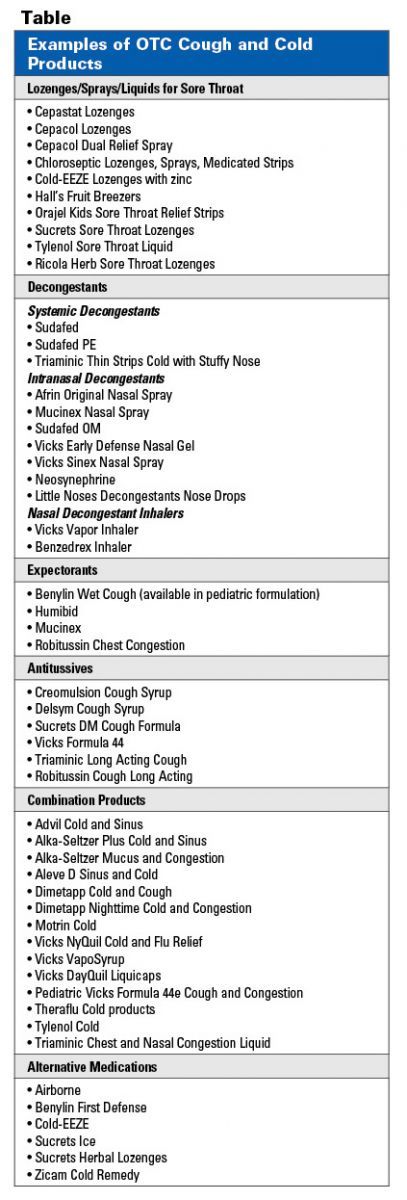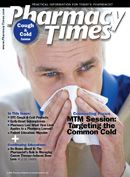Cough and Cold Products
Ms. Terrie is a clinical pharmacy writer based in Haymarket, Virginia.
It is estimated that Americans catch 1 billion colds every year.1,2 Colds are considered to be one of the leading causes of absence from work and school, and the Centers for Disease Control and Prevention reports that 22 million days are lost from school due to the common cold each year.2
More than 200 viruses cause colds, with the majority caused by rhinoviruses. 1,2 In general, the symptoms associated with the common cold appear within 1 to 3 days after incubation and typically begin with a sore throat, followed by sneezing, rhinorrhea, nasal congestion, headache, coughing, and malaise.1-3 Patients also may experience a low-grade fever; however, colds are rarely associated with a fever >100°F.1,2 Cold symptoms typically last for 7 to 14 days. Patients should be advised to seek medical care if their symptoms persist or worsen and if they exhibit any signs of infection, such as high fever and nasal or respiratory secretions that are not clear.1
Nonprescription products currently available for the management of cold symptoms include decongestants, antihistamines, expectorants, cough suppressants, and antipyretics/analgesics. In addition, various local anesthetic and antiseptic products are on the market for treating a sore throat.
In January 2008, the FDA issued a public advisory stating that cold medications should not be used in children <2 years of age.1,4 In October 2008, many manufacturers of cold medications agreed to voluntarily update product labeling to include: “Do not use in children under 4 years of age.”1,4 More information on cough and cold medications and the pediatric population can be found on the FDA Web site: www.fda.gov/ForConsumers/ ConsumerUpdates/ucm048515.htm.
A host of homeopathic and alternative medications, such as echinacea, high-dose vitamin C, and zinc, are commonly used by many individuals for the treatment of the common cold. Many cough and cold products are available as single-entity products as well as combination products. Products also come in formulations free of sugar, alcohol, dextrose, sucrose, sorbitol, sodium, fructose, glycerin, and dyes for the diabetic patient population, as well as for patients with hypertension, such as Coricidin HBP products, which are decongestant-free.
Local Anesthetics
For the temporary relief of a sore throat, products containing local anesthetics such as benzocaine or dyclonine hydrochloride are often used. These products are available as lozenges, throat sprays, and medicated oral disintegrating strips. These products may be used every 2 to 4 hours. Some products also contain local antiseptics such as cetylpyridinium chloride or hexylresorcinol and/or camphor or menthol.1
Decongestants
Decongestants are indicated for the temporary relief of nasal and eustachian tube congestion and cough associated with postnasal drip.1 Systemic OTC decongestants include pseudoephedrine and phenylephrine. Common adverse effects associated with the use of oral decongestants include insomnia, nervousness, and tachycardia. The use of decongestants also may exacerbate medical conditions that are sensitive to adrenergic stimulation (eg, hypertension, diabetes, coronary artery disease, prostatic hypertrophy, and elevated intraocular pressure).1
Many products on the market contain a combination of an antihistamine and a decongestant. Antihistamines and decongestants interact with several medications and are contraindicated in various patient populations. Pharmacists are key in identifying possible drug interactions, contraindications, or therapeutic duplications.
Examples of available OTC intranasal decongestants include ephedrine, epinephrine, levmetamfetamine, naphazoline, tetrahydrozoline, and oxymetazoline. Rhinitis medicamentosa (rebound congestion) is commonly associated with the use of topical decongestants, and their use should be limited to 3 to 5 days to avoid this condition.1
Products for Cough
Products available for treating cough include oral antitussives and expectorants and topical antitussives. Guaifenesin is the only FDA-approved expectorant and is indicated for the symptomatic relief of acute, ineffective productive cough.5 The use of guaifenesin is not associated with any drug— drug interactions and is generally well-tolerated, but adverse effects, such as nausea, vomiting, and gastrointestinal (GI) upset, have been reported.
The FDA-approved OTC oral antitussives (cough suppressants) include codeine, dextromethorphan, and di - phenhydramine.5 At antitussive dosages, codeine is classified as a Schedule V narcotic and is available without a prescription in 30 states.5 Codeine is considered to be the “gold-standard” antitussive.5 Codeine acts centrally on the medulla to increase the cough threshold; when used at antitussive doses, codeine has low toxicity and little risk of addiction.5
Many of the available OTC cough suppressants contain dextromethorphan, which is indicated for the suppression of nonproductive cough caused by chemical or mechanical respiratory tract irritation. 5
Examples of available dosage forms for dextromethorphan include syrups, liquids, suspensions, oral disintegrating medicated strips, liquid-filled gelcaps, granules, and lozenges. The most common adverse effects associated with dextromethorphan include nausea, vomiting, GI discomfort, dizziness, and constipation. Diphenhydramine is classified as a nonselective first-generation antihistamine. Though approved by the FDA as an antitussive, it is not considered a first-line antitussive. It acts centrally in the medulla to increase cough threshold. 5 Diphenhydramine is indicated for the suppression of nonproductive cough caused by chemical or mechanical respiratory tract irritation. Also available are topical creams, ointments, lozenges, vapor inhalants, and patches that contain the antitussive products camphor and menthol.5
Systemic Analgesics
When OTC analgesics are used for pain relief, headache, and fever associated with the common cold, caution should be used in those patients with a history of GI upset or renal or hepatic impairment, and those on medications that may interact with analgesics.1 Many combination cold products contain analgesics, such as aspirin, acetaminophen, ibuprofen, or naproxen, and patients should be advised to always check the ingredients of cold medications to avoid therapeutic duplications, possible drug—drug interactions, or contraindications.
Conclusion
Prior to recommending any cough and cold products, pharmacists should always screen for potential drug interactions, as well as possible contraindications. Factors to consider include the patient’s symptoms, concomitant medical conditions, allergy history, and current drug regimen, as well as lifestyle and personal preferences. Patients should be reminded to adhere to the recommended dosages, administration, and duration of use and to always use calibrated measuring devices when administering liquids. To prevent serious medication errors, patients should always be reminded to read labels prior to administration and check product expiration dates. Parents and caregivers should give children only those products manufactured specifically for the pediatric population and should always consult their pediatrician or pharmacist when in doubt regarding the appropriateness of medication. In addition to assisting patients in the proper selection of cough, cold, and flu products, pharmacists can reinforce the importance of using nonpharmacologic measures to provide relief of cold symptoms, such as vaporizers or humidifiers and saline nasal sprays, such as Ocean Nasal Spray or Breathe Right strips, to relieve nasal congestion. The importance of maintaining adequate hydration and rest should be stressed.
Various vapor products are also available to alleviate nasal congestion. In addition, it is beneficial to inform patients of various means of potentially reducing or preventing the transmission of colds, such as routine hand washing, use of hand sanitizers when soap and water are not available, avoiding direct contact with an individual with a cold, and always sneezing or coughing into a tissue, when possible, or elbow and not into the hand. Patients also should be referred to seek medical attention from their primary health care provider when necessary, especially if symptoms appear to worsen or linger.

For pharmacist-recommended Cough and Cold Products, visit the Cough/Cold/Flu section of www.otcguide.net.

